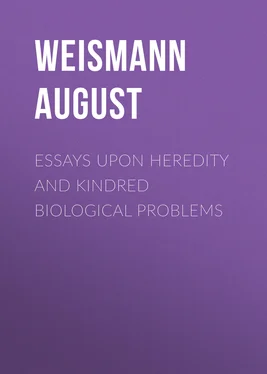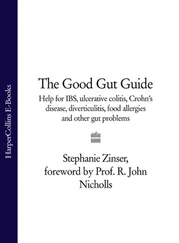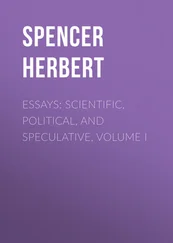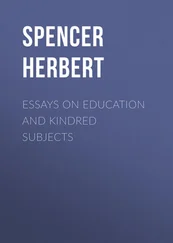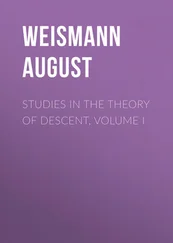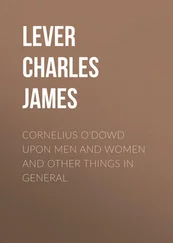August Weismann - Essays Upon Heredity and Kindred Biological Problems
Здесь есть возможность читать онлайн «August Weismann - Essays Upon Heredity and Kindred Biological Problems» — ознакомительный отрывок электронной книги совершенно бесплатно, а после прочтения отрывка купить полную версию. В некоторых случаях можно слушать аудио, скачать через торрент в формате fb2 и присутствует краткое содержание. Жанр: foreign_antique, Биология, на английском языке. Описание произведения, (предисловие) а так же отзывы посетителей доступны на портале библиотеки ЛибКат.
- Название:Essays Upon Heredity and Kindred Biological Problems
- Автор:
- Жанр:
- Год:неизвестен
- ISBN:нет данных
- Рейтинг книги:5 / 5. Голосов: 1
-
Избранное:Добавить в избранное
- Отзывы:
-
Ваша оценка:
- 100
- 1
- 2
- 3
- 4
- 5
Essays Upon Heredity and Kindred Biological Problems: краткое содержание, описание и аннотация
Предлагаем к чтению аннотацию, описание, краткое содержание или предисловие (зависит от того, что написал сам автор книги «Essays Upon Heredity and Kindred Biological Problems»). Если вы не нашли необходимую информацию о книге — напишите в комментариях, мы постараемся отыскать её.
Essays Upon Heredity and Kindred Biological Problems — читать онлайн ознакомительный отрывок
Ниже представлен текст книги, разбитый по страницам. Система сохранения места последней прочитанной страницы, позволяет с удобством читать онлайн бесплатно книгу «Essays Upon Heredity and Kindred Biological Problems», без необходимости каждый раз заново искать на чём Вы остановились. Поставьте закладку, и сможете в любой момент перейти на страницу, на которой закончили чтение.
Интервал:
Закладка:
Breeding experiments confirm these statements. P. Huber 17and Christ have already put the life of the female at three to four years, and Sir John Lubbock, who has been lately occupied with the natural history of ants, was able to keep a female worker of Formica sanguinea alive for five years; and he has been kind enough to write and inform me that two females of Formica fusca , which he captured in a wood together with ten workers, in December 1874, are still alive (July 1881), so that these insects live as imagos for six and a half years or more 18.
On the other hand, Sir John Lubbock never succeeded in keeping the males ‘alive longer than a few weeks.’ Both the older and more recent observers agree in stating that female ants, like queen bees, are always protected as completely as possible from injury and danger. Dr. A. Forel, whose thorough knowledge of Swiss ants is well known, writes to me,—‘The female ants are only once fertilized, and are then tended by the workers, being cleaned and fed in the middle of the nest: one often finds them with only three legs, and with their chitinous armour greatly worn. They never leave the centre of the nest, and their only duty is to lay eggs.’
With regard to the workers, Forel believes that their constitution would enable them to live as long as the females (as the experiments of Lubbock also indicate), and the fact that in the wild state they generally die sooner than the females is ‘certainly connected with the fact that they are exposed to far greater dangers.’ The same relation seems also to obtain among bees, but with them it has not been shown that in confinement the workers live as long as the queens.
Bees. According to von Berlepsch 19the queen may as an exception live for five years, but as a rule survives only two or three years. The workers always seem to live for a much shorter period, generally less than a year. Direct experiments upon isolated or confined bees, or upon marked individuals in the wild state, do not prove this, but the statistics obtained by bee-keepers confirm the above. Every winter the numbers in a hive diminish from 12,000-20,000 to 2000-3000. The queen lays the largest number of eggs in the spring, and the workers which die before the winter are replaced by those which emerge in the summer, autumn or during a mild winter. The queen lays eggs at such a variable rate throughout the year that the above-mentioned inequality in numbers is explained. The workers do not often live for more than six to seven months, and at the time of their greatest labour, (May to July), only three months. An attempt to calculate the length of life of the workers and drones by taking stock at the end of summer, gives six months for the former and four months for the latter 20.
The drones do not as a rule live so long as four months, for they meet with a violent death before the end of this period. The well-known slaughter of the drones is not, according to the latest observations, brought about directly by means of the stings of the workers, but by these latter driving away the useless drones from the food so that they perish of starvation.
Wasps. It is interesting that among these near relations of the bees, the life of the female should be much shorter, corresponding to the much lower degree of specialization found in the colonies. The females of Polistes gallica and of Vespa not only lay eggs but take part in building the cells and in collecting food; they are therefore obliged to use all parts of the body more actively and especially the wings, and are exposed to greater danger from enemies.
It is well known from Leuckart’s observations, that the so-called ‘workers’ of Polistes gallica and Bombus are not arrested females like the workers of a bee-hive, but are females which although certainly smaller, are in every way capable of being fertilized and of reproduction. Von Siebold has nevertheless proved that they are not fertilized, but reproduce parthenogenetically.
The fertilized female which survives the winter, commences to found a colony at the beginning of May: the larvæ, which hatch from the first eggs, which are about fifteen in number, become pupæ at the beginning of June, and the imagos appear towards the end of the same month. These are all small ‘workers,’ and they perform such good service in tending the second brood, that the latter attain the size of the female which founded the colony; only differing from her in the perfect condition of their wings, for by this time her wings are greatly worn away.
The males appear at the beginning of July; their spermatozoa are mature in August, and pairing then takes place with certain ‘special females which require fertilization’ which have in the meantime emerged from their cocoons. These are the females which live through the winter and found new colonies in the following spring. The old females of the previous winter die, and do not live beyond the summer at the beginning of which they founded colonies. At the first appearance of frost, the young fertilized females seek out winter quarters; the males which never survive the winter, do not take this course, but perish in October. The parthenogenetic females, which remain in the nest during the nuptial flight, also perish.
The males of Polistes gallica do not live longer than three months—from July to the beginning of October; the parthenogenetic females live a fortnight longer at the outside—from the middle of June to October, but the later generations have a shorter life. The sexual females alone live for about a year, including the winter sleep.
A similar course of events takes place in the genus Vespa . In both these genera the possibility of reproduction is not restricted to a single female in the nest, but is shared by a number of females. In the genus Apis alone is the division of labour complete, so that only a single female (the queen) is at any one time capable of reproduction, a power which differentiates it from the sterile workers.
Note 4. The Duration of Life of the Lower Marine Animals
I have only met with one definite statement in the literature of this part of the subject. It concerns a sea anemone,—which is a solitary and not a colonial form. The English zoologist Dalyell, in August, 1828, removed an Actinia mesembryanthemum from the sea and placed it in an aquarium 21. It was a very fine individual, although it had not quite attained the largest size; and it must have been at least seven years old, as proved by comparison with other individuals reared from the egg. In the year 1848, it was about thirty years old, and in the twenty years during which it had been in captivity it had produced 334 young Actiniae. Prof. Dohrn, of Naples, tells me that this Actinia is still living to-day, and is shown as a curiosity to those who visit the Botanical Gardens in Edinburgh. It is now (1882) at least sixty-one years old 22.
Note 5. The Duration of Life in
Indigenous Terrestrial and Fresh-water Mollusca
I am indebted to Herr Clessin—the celebrated student of our mollusca—for some valuable notes upon our indigenous snails and bivalves ( Lamellibranchiata ). I could not incorporate them in the text, for a number of necessary details as to the conditions of life are at present entirely unknown, or are at least only known in a very fragmentary manner. No statistics as to the amount of destruction suffered by the young are available, and even the number of eggs produced annually is only known for a few species. I nevertheless include Herr Clessin’s very interesting communications, as a commencement to the life statistics of the Mollusca.
(1) ‘ Vitrinae are annual; the old animals die in the spring, after having produced the spawn from which the young develope. These continue to grow until the following spring.’
Читать дальшеИнтервал:
Закладка:
Похожие книги на «Essays Upon Heredity and Kindred Biological Problems»
Представляем Вашему вниманию похожие книги на «Essays Upon Heredity and Kindred Biological Problems» списком для выбора. Мы отобрали схожую по названию и смыслу литературу в надежде предоставить читателям больше вариантов отыскать новые, интересные, ещё непрочитанные произведения.
Обсуждение, отзывы о книге «Essays Upon Heredity and Kindred Biological Problems» и просто собственные мнения читателей. Оставьте ваши комментарии, напишите, что Вы думаете о произведении, его смысле или главных героях. Укажите что конкретно понравилось, а что нет, и почему Вы так считаете.
